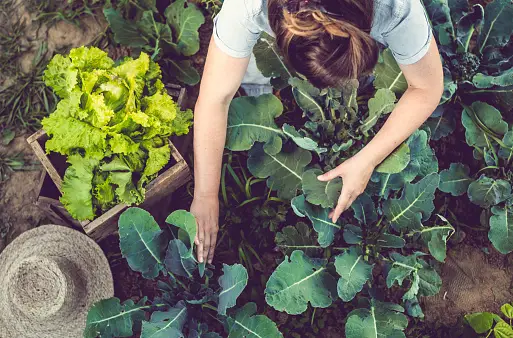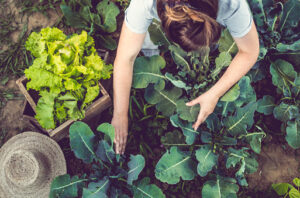If you’re looking for a way to save money on your grocery bill, consider growing your organic vegetables. It can be a fun and rewarding experience, and it’s not as difficult as you may think! In this blog post, we will provide step-by-step instructions on how to grow an organic vegetable garden. We’ll also discuss some of the benefits of gardening organically, and offer tips on how to get started. So what are you waiting for? Start planning your organic vegetable garden today!
Table of Contents
- 1 Why Organic Gardening Is Important
- 2 How to Prepare Your Garden for Planting
- 3 Planning Your Garden
- 4 Preparing the Soil – Add Organic Matter like Compost or Manure to Improve Soil Quality
- 5 Choosing the Right Plants – Some Vegetables Are Easier to Grow than Others
- 6 Watering Your Plants – How Often and How Much?
- 7 Fertilizers – Are Your Plants Getting Enough Nutrients Throughout the Season?
- 8 Weeding and Pests – Keeping an Eye Out for Pesky Weeds and Pests
- 9 Harvesting Your Organic Vegetables – How and When?
- 10 How to Care for Your Vegetable Garden – A Little bit of TLC Goes A Long Way
- 11 Recipes Using Fresh Organic Produce from Your Garden
- 12 Closing Thoughts
Why Organic Gardening Is Important
Organic gardening is a method of growing plants that involves using natural processes, materials, and practices. This type of gardening excludes the use of synthetic fertilizers, pesticides, herbicides, and GMO seeds.
Organic gardening is important because it helps to promote sustainable agriculture and protect the environment. Growing your organic vegetables is a great way to reduce your carbon footprint and do your part to protect the planet.
Organic gardening is also beneficial for your health. Studies have shown that food grown organically is higher in antioxidants and vitamins than conventionally-grown food. Eating organic vegetables can help to reduce your exposure to harmful chemicals and toxins, and may even boost your immune system.
Finally, organic gardening is a great way to connect with nature. Gardening can be therapeutic, and it’s a great way to get outside and enjoy the fresh air. Growing your food is also a satisfying experience, as you get to watch your hard work pay off when you harvest your crops.
How to Prepare Your Garden for Planting
Now that we’ve discussed some of the reasons why organic gardening is important, let’s take a look at how to get started.
If you’re new to gardening, you may be wondering how to choose the right plants for your garden. When selecting plants for your organic garden, it’s important to consider their water and light needs, as well as their growth habits. You’ll also want to choose plants that are appropriate for your climate and soil type. Once you’ve selected the right plants, it’s time to start planting!
Planning Your Garden
Before starting your organic garden, you will need to plan and prepare a suitable location. If you have a small space, such as a balcony or patio, you can grow your plants in containers. Otherwise, you will need to clear an area of your yard for planting.
It’s important to choose a location that gets plenty of sunlight and has well-drained soil. You’ll also want to make sure the area is free of any weeds or debris. Once you’ve selected the perfect location, it’s time to start preparing your soil.
Planning the layout is also another important step in ensuring a successful harvest. When planning your garden, be sure to leave enough space between each plant to allow for proper air circulation. You’ll also want to consider the placement of your plants, as some vegetables need full sun while others prefer partial shade. Once you’ve planned your garden layout, it’s time to start planting!
Preparing the Soil – Add Organic Matter like Compost or Manure to Improve Soil Quality
When it comes to planting organic vegetables, there are a few things to keep in mind. First, you’ll need to add organic matter to your soil before planting. This can be done by adding compost or manure to the soil. This will help to improve the quality of your soil and provide nutrients for your plants.
Second, you’ll need to make sure your plants have enough space to grow. When planting, be sure to leave enough space between each plant to allow for proper air circulation.
If you’re not sure how to test your soil, you can purchase a home testing kit from your local nursery or garden center. These kits will help you determine the pH level and nutrient content of your soil.
Choosing the Right Plants – Some Vegetables Are Easier to Grow than Others
Once you’ve prepared your soil, it’s time to start planting! When selecting plants for your organic garden, it’s important to choose varieties that are well-suited for your climate and soil type.
If you’re not sure which plants to choose from, you can ask your local nursery or garden center for recommendations. You can also look online or in gardening books for ideas.
Once you’ve selected the right plants, it’s time to start planting! Be sure to follow the instructions on the seed packet or plant tag for proper planting depth and spacing.
Watering Your Plants – How Often and How Much?
One of the most important aspects of organic gardening is watering your plants. how often and how much you water your plants will depend on a few factors, such as the type of plant, the climate, and the amount of rainfall.
In general, most vegetables need about an inch of water per week. You can water your plants using a hose, sprinkler, or soaker hose. If you’re using a hose, be sure to water at the base of the plant to avoid wetting the leaves.
If you’re using a sprinkler, you’ll need to water more frequently, as they tend to lose more water to evaporation. Soaker hoses are a great option for watering your plants, as they deliver water directly to the roots of the plants.
Fertilizers – Are Your Plants Getting Enough Nutrients Throughout the Season?
As your plants grow, they will need additional nutrients to continue producing. You can provide these nutrients by adding organic fertilizer to the soil.
How frequently should I add fertilizers?
This will depend on the type of fertilizer you’re using.
If you’re using a liquid fertilizer, you’ll need to apply it more frequently than if you were using a granular fertilizer.
You can also add organic matter to your soil, such as compost or manure, to provide nutrients for your plants. This is a great option if you’re looking for a more natural way to fertilize your plants.
There are many different types of organic fertilizer available, so be sure to ask your local nursery or garden center for recommendations. You can also look online or in gardening books for ideas.
Weeding and Pests – Keeping an Eye Out for Pesky Weeds and Pests
As your plants grow, you’ll need to keep an eye out for weeds and pests. Hand-pulling weeds are the best way to remove them, as it’s less likely to damage your plants. For pests, you can use a variety of organic methods to control them, such as traps, barriers, and even beneficial insects.
If you have a problem with pests, there are several organic pest control options available. You can ask your local nursery or gardening center for recommendations.
With a little care and attention, you can enjoy a bountiful harvest of fresh, organic vegetables from your very own garden.
Harvesting Your Organic Vegetables – How and When?
After you’ve planted your garden, it’s time to sit back and watch it grow! Depending on the plants you’ve chosen, your vegetables should be ready to harvest in anywhere from two to eight weeks.
When harvesting your crops, be sure to use sharp gardening shears or a knife. This will help to prevent damage to the plant.
You can also extend the harvest season by planting vegetables that mature at different times. This way, you’ll have fresh vegetables all season long!
Assuming you’ve followed all of these steps, you should now have a beautiful and bountiful organic garden! Enjoy your fresh fruits and vegetables, and be sure
The best time to harvest most vegetables is in the morning, before the heat of the day.
To harvest, simply cut or pull the fruit or vegetable from the plant. Be sure to check the maturity date on the seed packet or plant tag to know when your vegetables will be ready to harvest.
Assuming you’ve followed all of these steps, you should now have a beautiful and bountiful organic garden! Enjoy your fresh fruits and vegetables, and be sure to share your bounty with friends and family!
How to Care for Your Vegetable Garden – A Little bit of TLC Goes A Long Way
Once your organic vegetables are harvested, it’s important to give your plants a little bit of TLC(tender loving care). This will help them to stay healthy and produce bountiful crops in the future.
To care for your plants, be sure to:
- Water them regularly (at least once per week)
- Fertilize them every few weeks
- Remove any dead or dying leaves or flowers
Recipes Using Fresh Organic Produce from Your Garden
Now that you’ve harvested your organic vegetables, it’s time to enjoy the fruits of your labor! Here are a few delicious recipes that feature fresh, organic produce:
- Roasted Brussels Sprouts with Bacon and Parmesan: This dish is sure to please even the pickiest of eaters! Simply roast your Brussels sprouts in the oven with some bacon and Parmesan cheese.
- Garden Fresh Tomato Basil Soup: This soup is the perfect way to use up all of those fresh tomatoes from your garden. Serve it with a grilled cheese sandwich for a delicious and easy meal.
- Zucchini Bread: This classic recipe is a great way to use up any extra zucchini you may have. Be sure to add some chocolate chips for an extra special treat!
Closing Thoughts
Organic gardening is a great way to get fresh fruits and vegetables, while also being good for the environment. With a little bit of care and attention, you can enjoy a bountiful harvest of delicious organic produce from your very own garden. Happy gardening!



